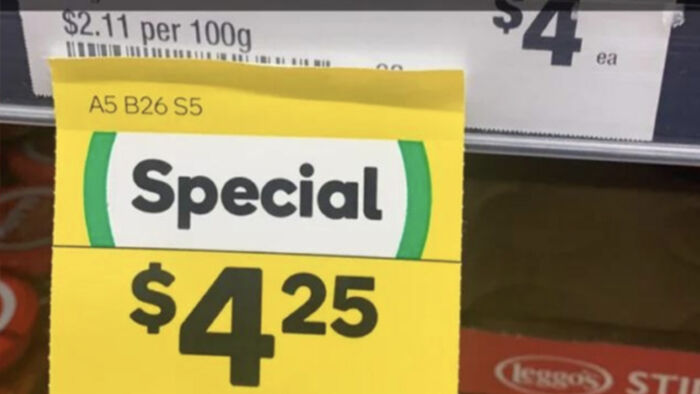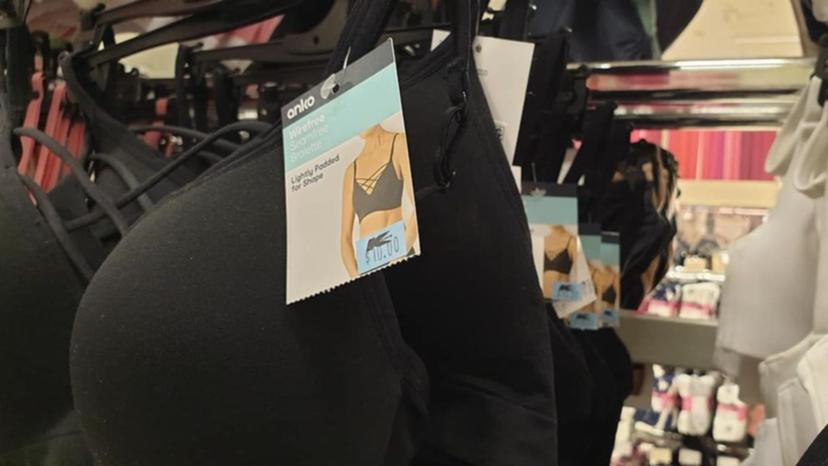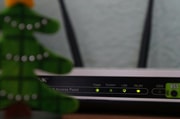Sale prices: How to avoid scams and get everything you're entitled to
- Replies 5
Recently, there have been a number of incidents in which the price tags on items in supermarkets have been 'misleading'.
One Coles customer found that the item's 'Special' price, which was supposed to be lower, was actually higher than its regular price. A similar thing happened to a Woolies customer, who found that it would be far better to pay the item's regular price.
Because of these issues, a few shoppers said they had peeled off the sticker to get the cheaper price at the register.
But can customers simply just peel off misleading price tags? Or are there other ways to stop these sneaky prices?

People on social media have criticised Woolworths for 'discounted' prices that are actually higher than the original prices. Credit: Facebook.
What happens if there are two different price tags on a single item?
Despite the fact that companies are free to determine their own rates as they see fit, there are very specific guidelines that govern how prices should be posted.
According to the Australian Competition and Consumer Commission (ACCC), the prices must be easy to understand, accurate, and not in any way deceptive to the customers.
Fair Trading NSW also says that it is against the law for a store to charge the higher price when an item has two prices marked on it. The only exception, according to the ACCC, is when one price is completely hidden by another.
Therefore, theoretically speaking, the shop is in the right as long as a higher-priced sticker totally blocks out a lower-priced sticker.
What about price hikes, shouldn't retail companies tell their customers about them?
Another question is whether companies must inform customers when prices change. Apparently, the answer is no.
Not unless you subscribe to a service or product. In that case, the provider needs to let you know about a price increase before you get a bigger bill.
When I scanned my item at the checkout, I saw that the price was higher than what was written on the shelf. That means it's free, right?
You have the right to get the product at no cost if the item scans for more than the price listed on the shelf. This provision is included in the voluntary Scanning Code of Practice, which some supermarkets have agreed to implement.
But you can't double dip.
Only the first item that is scanned erroneously will be given away for free if you purchase several goods that are identical. The remainder will be sold at the lower price indicated.
There are also things that this code doesn't cover, like items that cost more than $50.
Not every store has signed up for the code either. Price mistakes might be handled differently at independent supermarkets.

Kmart was criticised on social media for covering pre-printed price tags with higher stickers. Credit: Facebook.
But what about those crazy discounts? Are they even real?
If you've ever wondered if sales discounts like 'Was $500, now $250!' are real, the answer is yes. It is literally illegal for a store to 'lie' about their sale prices.
In accordance with the Australian Consumer Law, it is illegal for stores to inflate the 'before' price just to make their sales more enticing.
The original price must have been in place for a reasonable amount of time before the sale, though what's considered 'reasonable' can vary from retailer to retailer. As an example, one jewellery store was fined $250,000 for advertising a 'before' price that didn't apply four months before a sale.
What if I saw an item on sale online and thought it was a great deal, only to find out that the store put up the wrong price? Can they 'cancel' the sale, or do they have to give it to me at the price listed?
We are sorry to have to tell you this, but if a price appears to be too good to be true, it probably is. If a pricing mistake is real, a store may be able to cancel a sale, especially if no money has been exchanged.
Things can be somewhat different, though, if you have already paid for the item in question.
In 2016, a buyer ordered and paid for a $34,000 diamond ring in full via the jeweller's website, paying the listed price of merely $1,100. As a result, the jeweller was forced to sell the item for a discounted price.
The jeweller said that the ring was obviously priced wrong, but the NSW Civil and Administrative Tribunal didn't buy that argument, and the customer got the deal of the century.
If this isn't the bargain of a lifetime, we don't know what is!

It's possible that you'd have to fork over more cash than what you initially committed to. Credit: The Financial Express.
Is it possible that I would be required to pay more than the amount I already agreed to?
It is entirely possible. Right now, this is a real risk for people who want to buy a new car.
Problems in the supply chain are making it hard to get new cars to customers on time. According to the Price My Car website, the average wait time for a new car is currently 157 days. For popular cars like the Toyota Rav 4, the wait can go up to 339 days.
Due to rising inflation, your car may be more expensive when it finally arrives.
This can make it hard for buyers to pay a higher price, especially if they signed a contract that lets the dealer pass on a price increase.
So to our members who are looking to buy a new car, please take this as your sign to read the contract very carefully!
Where should I go if I have a concern with the prices that are being charged?
When you have questions about prices, you should always start by contacting the company involved. If that doesn't work, call the ACCC at 1300 302 502 or your state or territory's Consumer Affairs/Department of Fair Trading.
Better keep these tips close at hand, members! You never know when 'misleading' price tags will show up when you're shopping…
If you have any more tips for us, feel free to leave a comment below!
One Coles customer found that the item's 'Special' price, which was supposed to be lower, was actually higher than its regular price. A similar thing happened to a Woolies customer, who found that it would be far better to pay the item's regular price.
Because of these issues, a few shoppers said they had peeled off the sticker to get the cheaper price at the register.
But can customers simply just peel off misleading price tags? Or are there other ways to stop these sneaky prices?
People on social media have criticised Woolworths for 'discounted' prices that are actually higher than the original prices. Credit: Facebook.
What happens if there are two different price tags on a single item?
Despite the fact that companies are free to determine their own rates as they see fit, there are very specific guidelines that govern how prices should be posted.
According to the Australian Competition and Consumer Commission (ACCC), the prices must be easy to understand, accurate, and not in any way deceptive to the customers.
Fair Trading NSW also says that it is against the law for a store to charge the higher price when an item has two prices marked on it. The only exception, according to the ACCC, is when one price is completely hidden by another.
Therefore, theoretically speaking, the shop is in the right as long as a higher-priced sticker totally blocks out a lower-priced sticker.
What about price hikes, shouldn't retail companies tell their customers about them?
Another question is whether companies must inform customers when prices change. Apparently, the answer is no.
Not unless you subscribe to a service or product. In that case, the provider needs to let you know about a price increase before you get a bigger bill.
When I scanned my item at the checkout, I saw that the price was higher than what was written on the shelf. That means it's free, right?
You have the right to get the product at no cost if the item scans for more than the price listed on the shelf. This provision is included in the voluntary Scanning Code of Practice, which some supermarkets have agreed to implement.
But you can't double dip.
Only the first item that is scanned erroneously will be given away for free if you purchase several goods that are identical. The remainder will be sold at the lower price indicated.
There are also things that this code doesn't cover, like items that cost more than $50.
Not every store has signed up for the code either. Price mistakes might be handled differently at independent supermarkets.
Kmart was criticised on social media for covering pre-printed price tags with higher stickers. Credit: Facebook.
But what about those crazy discounts? Are they even real?
If you've ever wondered if sales discounts like 'Was $500, now $250!' are real, the answer is yes. It is literally illegal for a store to 'lie' about their sale prices.
In accordance with the Australian Consumer Law, it is illegal for stores to inflate the 'before' price just to make their sales more enticing.
The original price must have been in place for a reasonable amount of time before the sale, though what's considered 'reasonable' can vary from retailer to retailer. As an example, one jewellery store was fined $250,000 for advertising a 'before' price that didn't apply four months before a sale.
What if I saw an item on sale online and thought it was a great deal, only to find out that the store put up the wrong price? Can they 'cancel' the sale, or do they have to give it to me at the price listed?
We are sorry to have to tell you this, but if a price appears to be too good to be true, it probably is. If a pricing mistake is real, a store may be able to cancel a sale, especially if no money has been exchanged.
Things can be somewhat different, though, if you have already paid for the item in question.
In 2016, a buyer ordered and paid for a $34,000 diamond ring in full via the jeweller's website, paying the listed price of merely $1,100. As a result, the jeweller was forced to sell the item for a discounted price.
The jeweller said that the ring was obviously priced wrong, but the NSW Civil and Administrative Tribunal didn't buy that argument, and the customer got the deal of the century.
If this isn't the bargain of a lifetime, we don't know what is!
It's possible that you'd have to fork over more cash than what you initially committed to. Credit: The Financial Express.
Is it possible that I would be required to pay more than the amount I already agreed to?
It is entirely possible. Right now, this is a real risk for people who want to buy a new car.
Problems in the supply chain are making it hard to get new cars to customers on time. According to the Price My Car website, the average wait time for a new car is currently 157 days. For popular cars like the Toyota Rav 4, the wait can go up to 339 days.
Due to rising inflation, your car may be more expensive when it finally arrives.
This can make it hard for buyers to pay a higher price, especially if they signed a contract that lets the dealer pass on a price increase.
So to our members who are looking to buy a new car, please take this as your sign to read the contract very carefully!
Where should I go if I have a concern with the prices that are being charged?
When you have questions about prices, you should always start by contacting the company involved. If that doesn't work, call the ACCC at 1300 302 502 or your state or territory's Consumer Affairs/Department of Fair Trading.
Better keep these tips close at hand, members! You never know when 'misleading' price tags will show up when you're shopping…
If you have any more tips for us, feel free to leave a comment below!







